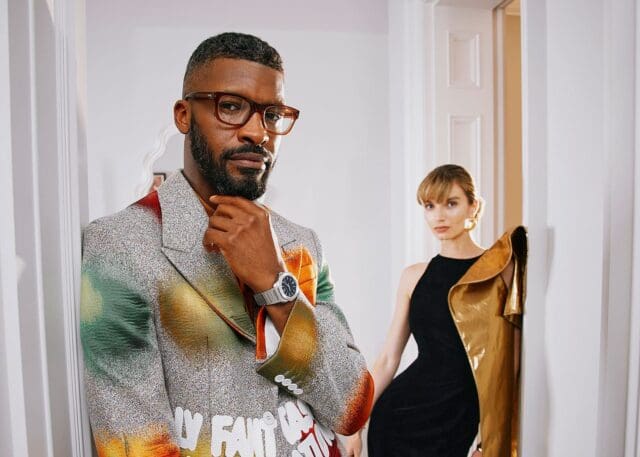
Tár’s Nina Hoss on Cate Blanchett and complex characters
In conversation with the star of the Oscar-tipped Todd Field film
When it comes to typecasting there are certain stereotypes that come to mind: the girl-next-door, the sassy sidekick, the superhuman action hero. Few and far between are the actors who find themselves repeatedly cast in the role of violin virtuoso. Except, that is, for Nina Hoss.
Hoss’ role in Todd Field’s highly-anticipated Tár will be no less than her third on-screen outing as a classical musician, with previous credits including a role as a professional violinist with PTSD in Ina Weisse’s The Audition.
An accomplished piano player in real life, in Tár, Hoss plays Sharon Goodnow; the Berlin Philharmonic’s first violinist, wife of the eponymous Lydia Tár (the groundbreaking fictional conductor played by Cate Blanchett), and mother to their young daughter, Petra. The audience meets Tár at the height of her career, as she’s preparing for a book launch and a much-anticipated live performance of Mahler’s Fifth Symphony. Over the ensuing weeks her life, and that of her family, begin to unravel as Tár faces accusations of systemic abuse.
Upon receiving the script, Hoss was instantly intrigued but, as she delved deeper, became struck by the film’s complexity and beauty. “When I read the script I felt so challenged and unbalanced because I didn’t understand everything,” she explains. “I wanted to dive in and understand more. That kept me going and now the most beautiful thing is that the audience feels the same way.”
And, while her previous roles may seem like good training, Field’s immersive set proved a challenge unlike anything Hoss had experienced before. Field insisted that all the orchestral scenes took place authentically, calling in the real Dresden Philharmonic to be conducted by Blanchett, while Hoss performed as the real first violin, the second-in-command to the conductor.

“[Performing with the Dresden Philharmonic] was incredible. It was one of those moments where you think ‘I love my job!’ It takes you to places and gives you a glimpse into other people’s lives and realities.”
Hoss recalls the nerve-wracking moment the pair rehearsed with the orchestra for the first time: “[Cate] lifts her hand up and there is this sound. I stopped playing for a moment. It’s just something out of this world. I turned around to the musicians and said, ‘That’s what you get to do every day?!’”
Field’s method-style approach may demand more of his actors than other directors but, says Hoss, performing with the orchestra and being that immersed also helped her gain a greater understanding of her character and the power dynamics at play in the movie.
“Cate is a most fascinating actor and she immerses herself so much into whatever she takes on.”
Nina Hoss
“Sharon is the diplomat and she is like a psychiatrist in a way,” Hoss says. “She knows how to take each member of the orchestra in their own right. They have very strict rules and it’s a constant negotiation to keep everyone engaged and happy. Watching Wolfgang Hentrich, the real first violin of the orchestra, was really informative for [playing] Sharon. You can’t be a dictator because then they wouldn’t work with you. You need to be a real diplomat. It’s quite striking.”
It’s a parallel that can quite easily be drawn with Field’s own directorial style, who has previously said about his process, “the important thing in this relationship is not who wears the pants. It’s about complicity.” This democratic and fluid process of making a movie was something Hoss says she found particularly refreshing.
“He [Field] has a vision but how we get there is very collaborative. It’s not about who has a better idea or not being able to mention if you have an idea. It’s about finding the most nuanced way of telling the story and that went through to the very final edit.”

The pieces of a film that end up on the cutting room floor can often be as interesting and telling as what did end up in the final edit. In the case of Tár , Hoss says, many scenes didn’t make the cut because they would have explained too much and narrowed the audience’s viewpoint.
“In that way, he [Field] is incredibly smart but also tough on himself because he wrote these scenes, he shot these scenes and he loves these scenes. Taking them out isn’t easy. But that’s why the end product is the way it is – because he is questioning and working on it until the very last moment. It’s really striking to watch.”
We’re speaking the day after the Golden Globes, where Tár narrowly missed out on best screenplay and picture gongs, while Cate Blanchett scooped the award for Best Actress in a Drama Motion Picture. Accordingly, stellar reviews have Blanchett hotly tipped to win the Oscar for Best Actress as well.
What was it like for Hoss to perform opposite such a Hollywood powerhouse? “Cate is a most fascinating actor and she immerses herself so much into whatever she takes on. That is fascinating and challenging in the best way, and I love a challenge.
“She's a very generous, beautifully funny, smart, highly intelligent and witty person so it was really easy to become this couple in front of the camera. There was a certain easiness to it; it didn't feel forced at all.”
Tár is in cinemas from 13 January 2023.






